A Guide to API Development [Cost, Skills, tools and Best Practices]
The global Application Programming Interface management market is estimated to reach $13.7 billion by 2027 (GlobalNewsWire).
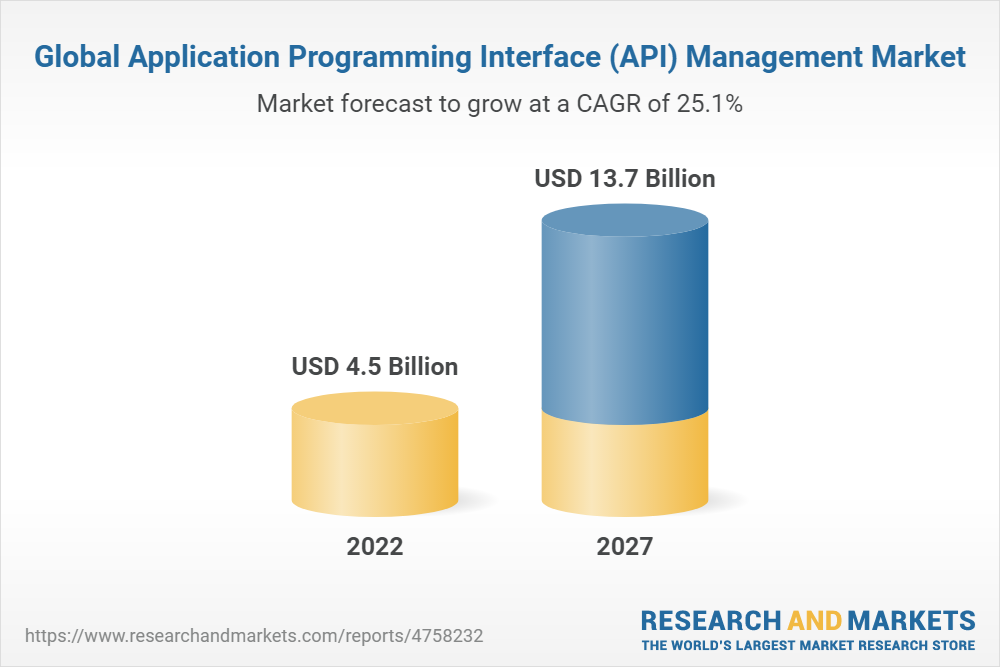
API is core to mobile application development. Most developers rely heavily on APIs to introduce the numerous features required to boost the application.
Developers use APIs whether they want to integrate payment gateways into the application or add a social media channel. This is the fastest-growing niche, as a lot of development occurs via the interface.
It can streamline the processes and enhance the development speed, thus allowing you to deploy your apps before the competition.
At the same time, APIs allow you to employ complex functionality without investing time in coding or creation.
This blog will discuss the importance and types of API. We will take you through the tools, cost and best practices to build an API for your business requirements.
What is API?
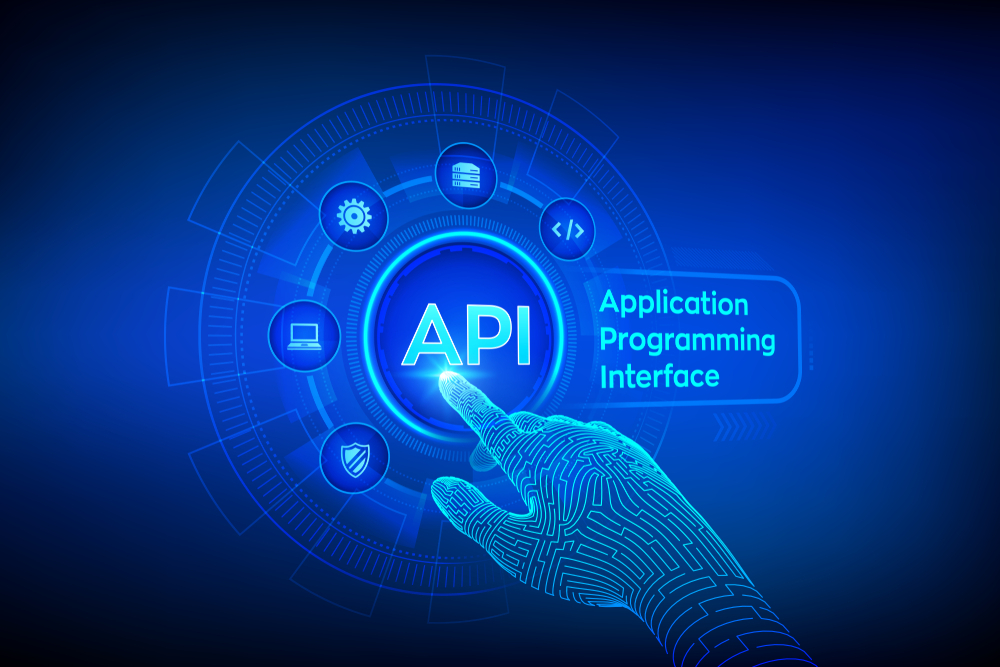
API (Application Programming Interface) is a gateway allowing businesses to add one app's data and functionality to another seamlessly. The interface separates the systems and applications for better collaboration and seamless data transfer.
API development is tedious and requires technical understanding. However, with the right documentation, you can easily integrate the API into your business application with the right documentation.
The ease of adding functionality and enhancing applications has led to increased API usage in modern-day app development.
There are three essential components of API that you should understand:
1. Procedures: The program will cover this particular task or function. For example, if you are using Notion for planning, you need a real-time messenger for communication. Slack integration can ensure you communicate seamlessly without leaving the application.
2. Protocols: This is an API format to transfer the data between two applications. It is important to ensure that both applications use the same format.
3. Tools: These are the foundation or basic blocks that help developers create the programs needed for the particular application.
APIs act as mediators and allow the developers to create new interactions. As a result, the developers don't need to create an app feature or functionality from scratch.
How does API Work?
To understand the working of an API, we will understand each part.
1. Application: This is the application you aim to use to complete the transactions. For instance, if you want to use Slack for messaging, that is the application. All the applications that you can use for passing information will enter this category.
2. Programming: While a new application requires programming and a lot of coding, API helps avoid chaos. You can use the existing applications without writing new code or building another logic.
3. Interface: This is the way an application interacts with another.
APIs are application interactions built to avoid coding or programming the feature from the ground up.
Importance and Types of API
It has become increasingly important as more businesses use APIs to incorporate functionality. Here are some of the reasons to develop APIs.
- You can foster innovation with the right APIs to enhance the app experience. For instance, by adding relevant features and functionality, you can make the app more engaging for your users.
- Accelerates app development as you don’t need to build all the essential features from the ground up. By adding the relevant APIs, you can release the applications.
- Enables quick data transfer and movement to enhance the developer’s productivity and make the processes super efficient.
Here are all the types of API you should know:
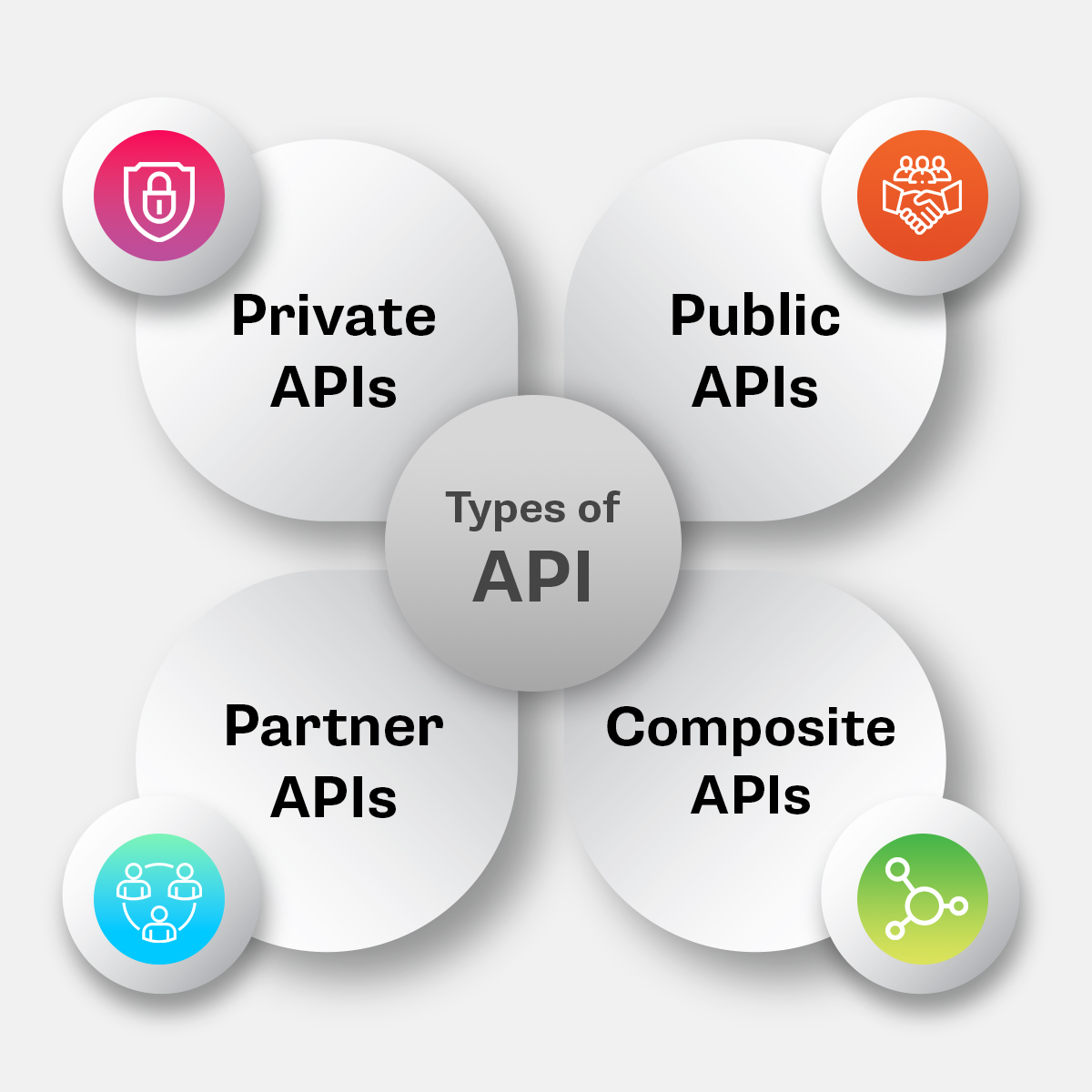
1. Private APIs: With these APIs, you can enhance the services and solutions within an organisation. This interface is made available for the API publisher. You can easily incorporate the complete API in your services.
2. Public APIs: Developer-centric APIs developed to improve brand awareness. They are built with the required monetisation strategy.
3. Partner APIs can help boost software integration between the parties concerned. It allows smooth integration and improves communication and data transfer between the entities.
4 Composite APIs: Combining the service and data APIs, you get composite APIs. It can help you introduce the different tasks within a single application.
API Terms You Should Know
As you learn about APIs, knowing the relevant terms to help you build an efficient solution is equally important.
1. API Key: This is an authentication code. It allows the API to know the user who has raised the request and allow them in.
2. Endpoint: The point where two APIs communicate or one API communicates with the entire system.
3. JSON: This data format is used for requests and responses through interactions.
4. GET: This is the HTTP method that the RESTful API uses to gain access to resources.
5. POST: The HTTP method that the RESTful APIs use to build requisite resources.
6. OAuth: Open Standard Authorization Framework allows the users to access the API without the necessary credentials. This is one of the top open source authentication tools.
7. REST: This programming architecture allows efficient communication between systems or devices.
9. SOAP: Simple Object Access Protocol is the messaging protocol used in web services execution. It works in tandem with XML information.
10. Latency: This is the time the API interface takes to process the requests and manage the response.
11. Rate Limiting: The total number of requests a single user can send to the API is rate-limiting. You can easily decide on a single number to reduce the load.
12. API Throttling: This includes the process of regulating API usage for a particular time period. You can set a limit of 1000 API requests in a single day. You will notice an error message displayed as soon as the number exceeds.
Must-have Features for a Popular API
There are certain specific features that you need to add to your API. It can enhance the usability and accessibility of the API.
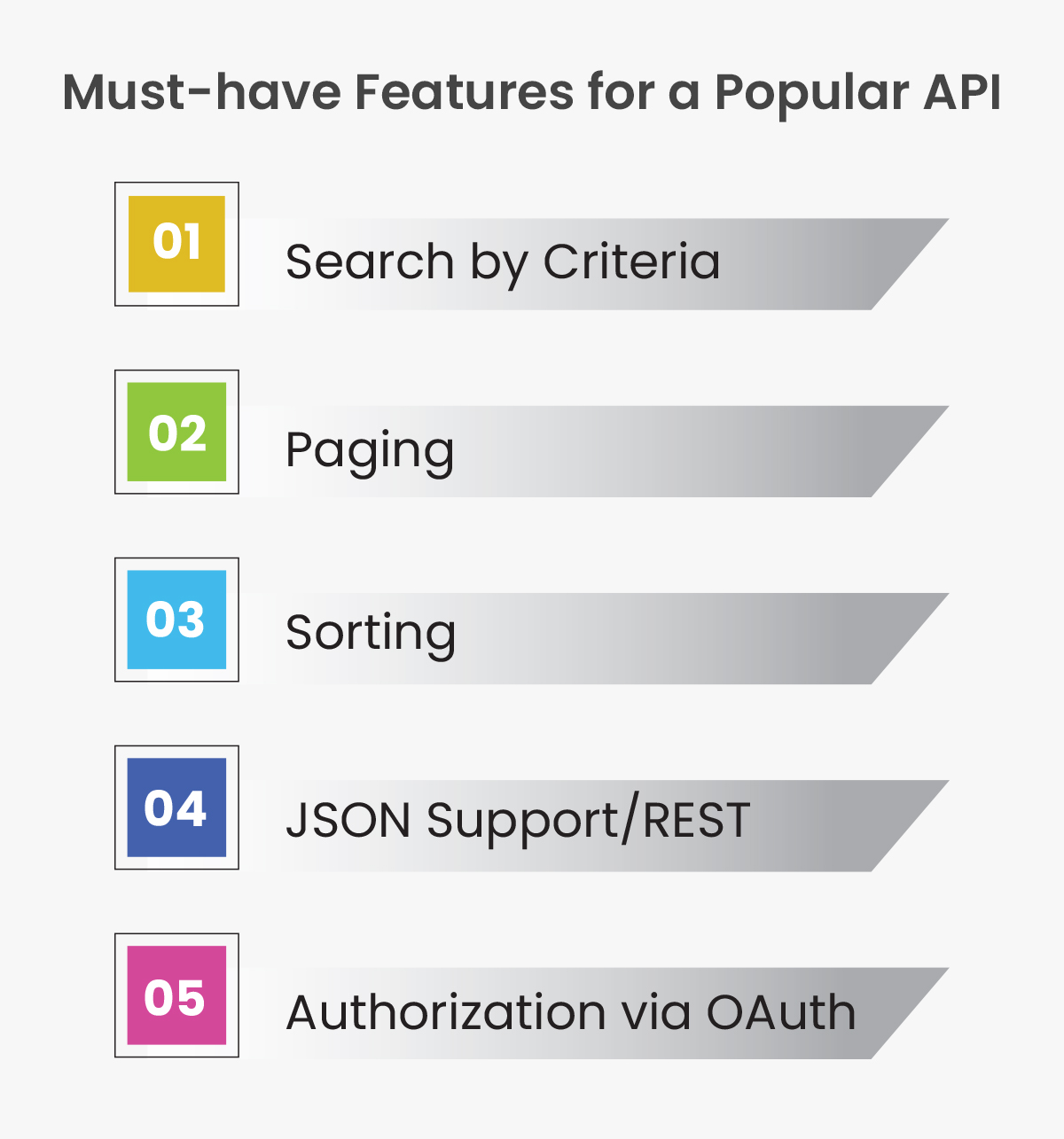
#1 Search by Criteria
This is a basic feature to include in your API. The customers should be able to search the data within the application interface using different criteria. You might want to consider the data synchronisation updates to implement this feature.
#2 Paging
The API should be able to showcase the exact changes the application requires. For instance, you may want to display only a particular part of the data with a definite frequency in some cases. Using the Paging feature, you can set the number of pages to display along with other parts.
#3 Sorting
The end user on your applications must receive the pages one by one. The sorting feature will ensure that the users can sort the data as per the date and time of modification.
#4 JSON Support/REST
It is important to use a RESTFul API or one that offers JSON format support for better communication. It is stateless and lightweight, which makes uploads and different processes smooth for the user.
#5 Authorization via OAuth
Security within the APIs is an important part and a must-have feature. You should introduce the authorizations via OAuth, as they are considerably faster and smoother. It reduces the processing time and enhances the ability of your API in the long run.
API Development Process
There is a guided 5-step process that you can follow to develop an API that can be useful to app developers. Here are all the steps that you should implement.
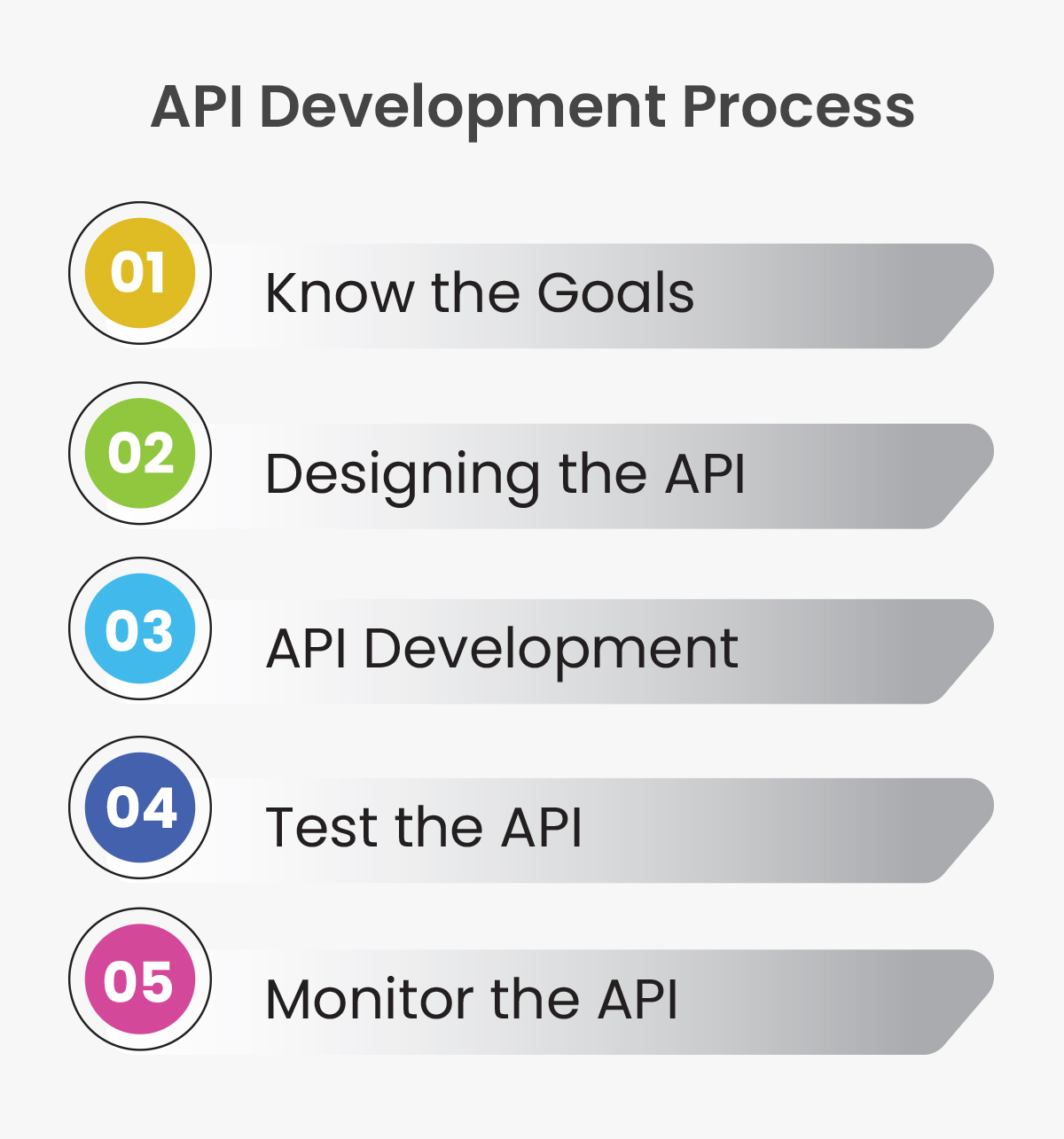
#1 Know the Goals
When designing the API, you should ensure it brings value to your organisation and the customers of the API. As a result, knowing the purpose of the API and its intended customers can help you. For example, private APIs are developer-centric. You would need to develop keeping them in mind and ensure it can add value to their app creations.
- What kind of API are you planning?
- What is the purpose of the API?
- How can you enhance the developer’s experience with the API?
You can quickly identify the API goals and customers by answering these questions. You can plan your development accordingly, and ensure a smooth experience. Remember your goals to build a web application versus a mobile application will differ.
#2 Designing the API
The architecture and interface design of the API is extremely important. You might want to plan your design considering the defined target audience and goals.
The API should be usable with the basic learning curve that the developers already have. Similarly, your API should be reliable and scalable. If the application load increases, the API should immediately support it.
It should be easy for the testing team to assess the API. Debugging should be a smart and responsive process.
Here are a few things to keep in mind when designing the API:
- Divide the entire API into client, validation, caching, orchestration and business logic layers for easy development.
- Two architectural styles are popular with API development- REST and SOAP. You should choose the style that fits your purpose.
- You should develop the API while keeping the security of the interface in mind. The API would be used in third-party services, so security should be good.
#3 API Development
Once the designs are ready, it is important to work on the development. Make it iterative for the best outcomes. You will be able to test as you develop the application.
Start by defining the API responses for your particular design. You must understand how a successful reply would look versus an error response.
When developing the API, you should ensure it can handle the exceptions and return the HTTP status codes.
The API endpoint is essential when you are developing the service. It is one of the biggest communication channels, as discussed earlier.
Implement the features we discussed in the must-have features to enhance the functionality.
#4 Test the API
Once you have completed the development phase, it is important to test the working of the API. You should check for the factors we ranked important during design- reliability, security, usability and performance. You should test each layer and component of the API separately.
Identify the results and monitor them individually to improve the API’s ability. Complete the load and performance testing before going live. You should use appropriate testing tools for better results.
#5 Monitor the API
Continuous monitoring is essential to review the API and enhance the outcome. It will help identify the system's errors and detect how you can solve them. user feedback is equally important in optimising the API.
There are a few things that you should necessarily track:
- API uptime
- Requests handled in a month
- Response time
- Server/memory usage
- Time is taken to receive the API key
The Best Practices that Make a Great API
Check out all the best practices you should adopt to make an incredible API for your business.
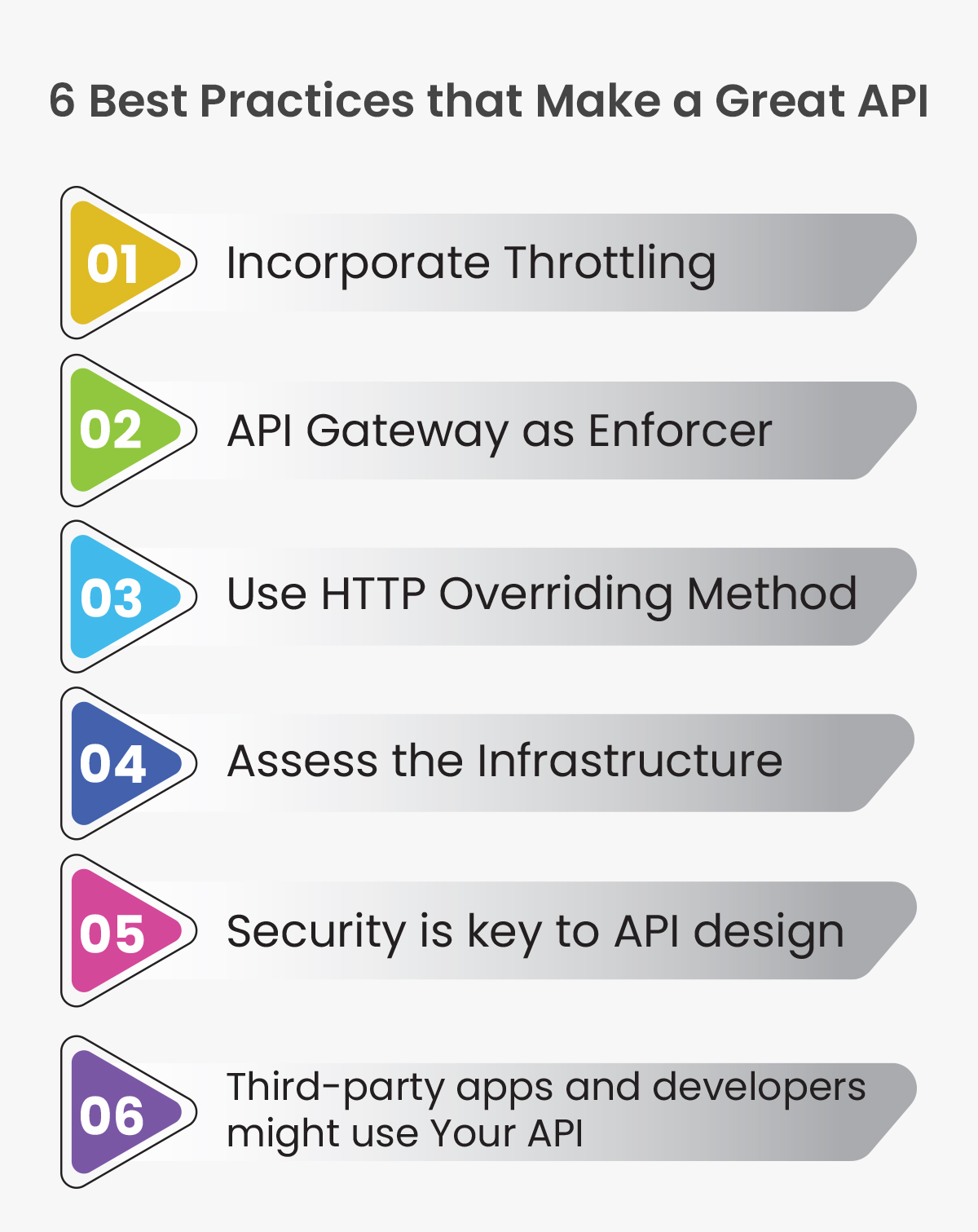
1. Incorporate Throttling: With Throttling in your API, you can break the traffic and back up the APIs. It will improve your APIs security against the Denial of Service attacks.
2. API Gateway as Enforcer: You must consider several aspects when bridging security within the application. The gateway to security within the API should be defined as that would be the enforcement point. You can use API keys or OAuth to encrypt the message and improve confidentiality.
3. Use HTTP Overriding Method: You should use the HTTP method to ensure the RESTFul web services override. You can implement the custom HTTP header, X-HTTP, for the override. It will improve the functionality.
4. Assess the Infrastructure: Monitoring your API's architecture and infrastructure is important. You will notice memory leaks and CPU drainage. Some tools can help observe the infrastructure and architecture. You will eventually be able to prevent the issues.
5. Security is key to API design: From the architecture to the technology, everything should be hacker-proof. The API should be designed considering the safe data transfer between applications.
6. Third-party apps and developers might use Your API: You should have a defined document to help the developers integrate the API and utilise the information to create their solutions. Documentation can also help your developers test quickly and optimise the API services.
Tools for Efficient Development
API development can be challenging if you do not use the right and effective methods. Here, we will take you through some of the top tools that make development efficient and effective.
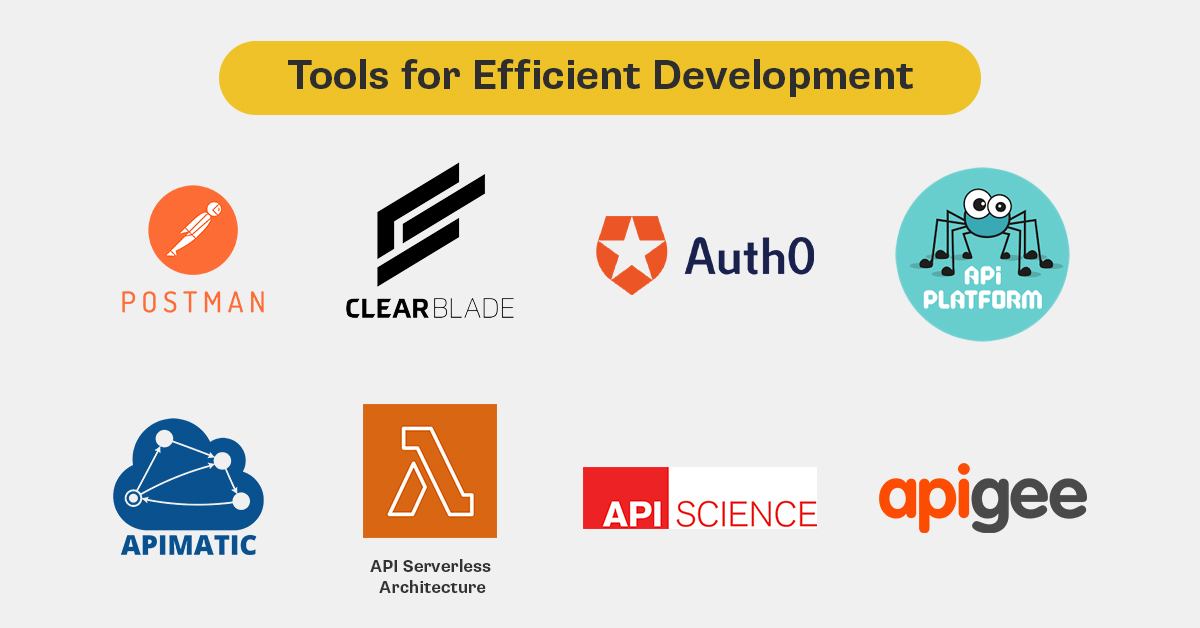
1. Apigee: This tool is backed by Google. It is an API management service provider that helps you develop a personalised API development approach.
2. API Science: It is a REST API development tool. Using this tool, you can quickly evaluate the internal and external components of the API and optimise them for continuous use.
3. API Serverless Architecture: You can use these tools to design, build and publish the APIs aligned with your business goals.
4. APIMatic: This tool helps developers automatically generate code snippets and SDKs. This will speed up API development.
5. API Platform: This PHP framework allows you to accelerate web API development.
6. Auth: You can use this tool to authenticate and manage your APIs.
7. ClearBlade: It is used to implement IoT technology within API development.
8. Postman: It is used to run, test, document and assess the API performance.
Top Skills API Developers Should Have
Your developers should possess the skills that are important to offer a seamless API:
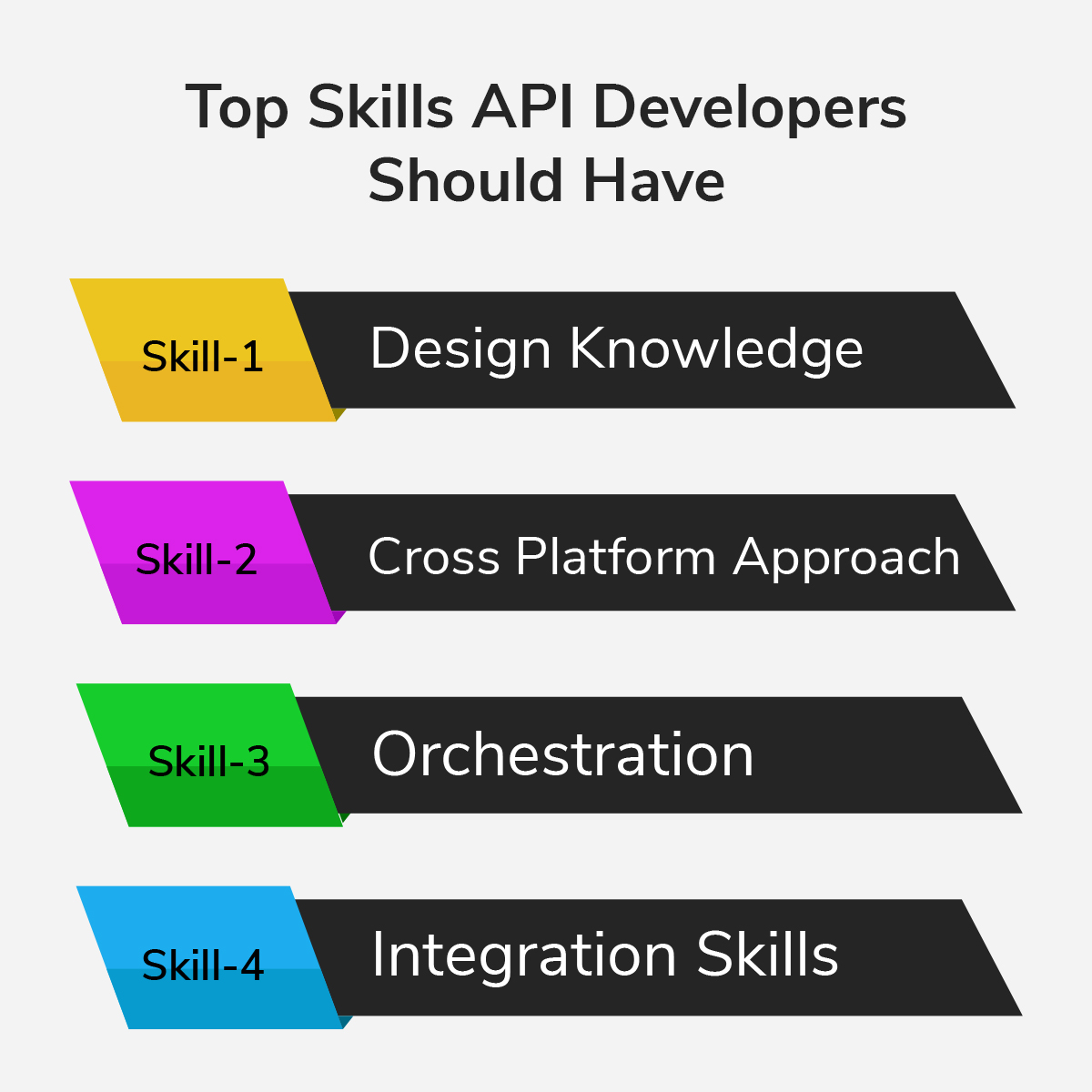
1. Design Knowledge
The developer should have an understanding of the design to connect two APIs. The design skills will help the developers create the requisite connections, build the micro servers and design the applications. With the right design skills, the developers will know how to expand the abilities of a system.
2. Cross-Platform Approach
It is important to reach users across multiple operating systems. That’s why you need to possess cross-platform framework knowledge. the right capabilities can help the developers deliver able APIs for multiple platforms.
3. Orchestration
this is an important skill for API developers. The APIs should be able to work with other APIs, which can be created via Orchestration. the developers should know how to enable the right code and build in the orchestration.
4. Integration Skills
The APIs should integrate with the mobile apps for feature enhancement. It is important for developers to understand how the multiple code lines can work towards enhancing integrations in the systems.
Cost of API Development
When planning API development, the budget plays a crucial role. You can define the goals, identify the metrics and decide the best approaches when you are aware of the budget.
The minimum cost of developing an API MVP is $15k. This would go up depending on the features and design approaches.
Here are all the factors that impact API development:
1. Hiring the Developer: You need to hire the right developer, who can help you with the API. your developer cost will increase/decrease depending on their skills, proficiency and experience
2. The Development Time: It is important to plan the development time. This can help you allocate resources efficiently. The time calculated includes- the research time, the time taken to create the database and the prototype development period
3. The functionality: It is important to consider the suited functionality when designing the API. Role-based controls, limiting restrictions and logging capability are functions that is crucial to API development. The functionality can also impact the cost of development.
Conclusion
API development is a continuous process. You cannot create or design an API and leave it. Continuous improvement, required development and testing is important to keep the API running.
You should define the goals and key metrics to ensure smooth optimisation. Ensuring best practices while coding and deploying your API is equally important.
Expert App Devs is an expert software development company with proficiency in API development. Our team has delivered several API services that can boost the functionality of your mobile app. Connect with our team if you want to build an API or optimise it. We can propose the best process and an effective solution for you.
 Vaibhav Patel
Vaibhav Patel
![Application Programming Interface Development Guide API Development Guide [Cost, Skills, tools and Best Practices]](https://www.expertappdevs.com/sitebucket/blog/20230424125539-Application-Programming-Interface-Development-Guide.jpg)




